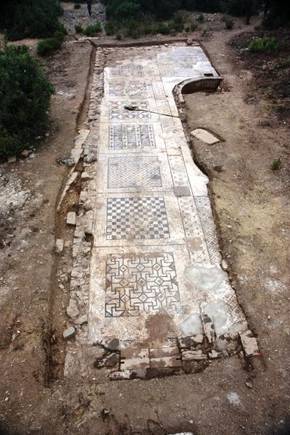Newsreel
It’s not what you think. Unless you think I’ve started subscribing to the National Geographic school of post-naming, in which case you’re a little right. There’s a lot of neat things going on in classics and medieval studies this week. For scholarship, there’s a great article on the influence of J. R. R. Tolkien, and for field archaeology we have a new insight into the archaeology of the Etruscans, and an amazing Roman mural that was just discovered in Turkey. No results on the Richard III tests yet, and I’ll ignore the controversy over his burial until we know if it’s really him or not, because that’s how we do science. Anyway…
Rubber Duckie, You’re the One
Archaeologists have discovered a 1600 square foot mosaic in a Turkish farmer’s field, which would have laid next to a huge Roman bath. The mosaic, not the farmer’s field. Dating back to the third or fourth century, the site is part of the ancient city Antiochia ad Cragum, which contains an early Christian basilica, a number of tombs and baths, and a marketplace. A team from the University of Nebraska-Lincoln, led by Professor Michael Hoff, has been invited to excavate and preserve the site, which Hoff discovered on a survey in 2001. The mosaic is a great example of Roman styles of decoration, and emphasizes just how far Roman culture stretched at the height of the empire, reaching across the Mediterranean to a mighty city in southern Turkey. Read the full article at the Register, and check out the mosaic below.
The Hidden Pyramids of Etruria
 Archaeologists from St. Anselm and the Parco Archeologico Ambientale dell’Orvietano have found some strange Etruscan constructions beneath a wine-cellar in Italy. We know little about the Etruscans, a people who flourished in Italy for centuries prior to the ascension of Rome, and this discovery only adds to the mystery. The structures are pyramids carved into the rock, so far dating as far back as the fifth century BCE. They pyramids, which are definitely not quarries or cisterns according to Claudio Bizzarri, of the Parco Archeologico Ambientale dell’Orvietano, but speculation abounds as to their purpose. The dig hasn’t even made it to the bottom of the structures yet, so we’ll be keeping a close eye on this one. One thing’s for sure, it’s not aliens. Read the full article at Discovery News.
Archaeologists from St. Anselm and the Parco Archeologico Ambientale dell’Orvietano have found some strange Etruscan constructions beneath a wine-cellar in Italy. We know little about the Etruscans, a people who flourished in Italy for centuries prior to the ascension of Rome, and this discovery only adds to the mystery. The structures are pyramids carved into the rock, so far dating as far back as the fifth century BCE. They pyramids, which are definitely not quarries or cisterns according to Claudio Bizzarri, of the Parco Archeologico Ambientale dell’Orvietano, but speculation abounds as to their purpose. The dig hasn’t even made it to the bottom of the structures yet, so we’ll be keeping a close eye on this one. One thing’s for sure, it’s not aliens. Read the full article at Discovery News.
The Long Arm of the Shire
We live in a world fascinated by fantasy and the medieval, and that’s become especially apparent with the works of J. R. R. Tolkien. The Hobbit and the Lord of the Rings have been read by generations, and the films enjoyed unprecedented success worldwide, taking the Oscars by storm. A recently completed honours thesis from Michael Hall, of Southern Illinois University Carbondale examines how Tolkien’s work has taken hold in the public consciousness, tracing the history of Middle Earth’s popularity, and how art and popular culture influence each other. Learn how a quiet university professor became a literary giant whose works have had a profound influence in modern media. You can find the paper in full through Medievalists.net.
And that’s what we’ve got for this week! Have you heard about something amazing going on in classical or medieval studies? Let us know by emailing us at uwlabyrinth@gmail.com, or by tweeting us at @UWLabyrinth, and have your story featured here!


Leave a Reply